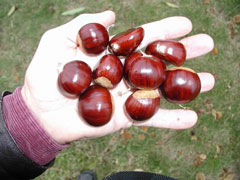


Home
Flowers &
Indoor Plants
Fruits & Nuts
Ornamentals
Vegetables
Special Topics
Resources
Glossary

 |
What about it? There are about twelve species of chestnut originating over wide area of the northern temperate zone. The American, European, Japanese, and Chinese chestnuts have all been cultivated for food since ancient times. Unfortunately, our American chestnut suffered a blight in this century, and few are left. This stately tree was valued for its beautiful wood as well as its nuts. The Chinese chestnut is still grown in New York state today. This tree can get as tall as 50+ feet. In the summer it sports flowers that are small and white on large catkins. Hybrids of the American Elm are available as well. What is it used for? Chestnut trees in the yard are valued for their shade and ornamental purposes, in addition to producing nuts. Chestnuts may be roasted or used in cooking. Where does it grow? How do we grow it? Chestnuts perform well in average soils with good drainage. The chestnut is tolerant of poor soils, but the harvest from trees grown on those sites will be smaller. Trees grown in heavy clay or poor drainage tend to be short-lived. The chestnut also requires a plentiful water supply to produce good crops. It needs full sun. Give the chestnut plenty of room to grow (at least 35-40 feet from other trees or buildings). What are its primary problems? The main disease of the chestnut tree is chestnut blight, which has destroyed large areas of trees in America, Europe, and Japan. Chestnuts can also be bothered by leaf spot diseases. The main insects found on the chestnut include the chestnut weevil, asiatic oak weevil, and mites. How do we harvest and store it? Chestnuts are ripe when they fall to the ground. Nuts can be picked from the tree or harvested after falling to the ground naturally. The nuts should be harvested at least every other day to get them before the squirrels do; these chestnut-lovers must wait until the 'burrs' of the chestnut open to allow them to get to the nut. Chestnuts are perishable because they lose water rapidly at room temperature and therefore dry out quickly. To cure and store nuts, place containers in a cool, ventilated place, and leave the containers partially open to allow moisture to escape. Or, mix dry peat moss with the nuts to absorb excess moisture.
© Copyright, Department of Horticulture, Cornell University. |

